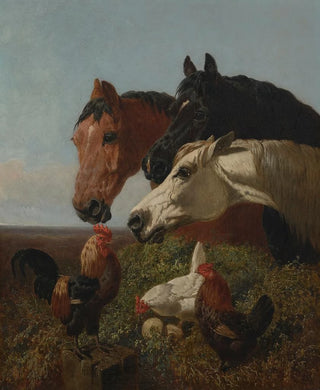Art print | The Friends of the Farm - John Frederick Herring Jr.


View from behind

Frame (optional)
In the vast panorama of art history, certain works stand out for their ability to capture the very essence of rural life. "Les amis de la ferme" by John Frederick Herring Jr. is a shining example. This canvas, imbued with tenderness and nostalgia, invites the viewer to immerse themselves in a universe where nature and friendship blend harmoniously. Through this art print, one can feel the echo of children's laughter and the whisper of animals, creating a warm and soothing atmosphere. The piece does not merely depict a scene from everyday life; it evokes memories of innocence and complicity, making it a true visual treasure.
Style and uniqueness of the work
Herring Jr.'s style is characterized by meticulous attention to detail and a vibrant color palette that breathes life into his compositions. In "Les amis de la ferme," the characters are portrayed with palpable tenderness, each expression and gesture reflecting a deep human connection. The shades of green in the fields, the warm browns of the animals, and the flashes of light dancing across the canvas create a captivating visual harmony. The way the artist plays with light and shadow gives an almost three-dimensional quality to the scene, allowing the viewer to feel immersed in this moment frozen in time. Herring Jr. manages to transcend mere representation to offer a true visual narration, where each element contributes to the overall harmony of the piece.
The artist and his influence
John Frederick Herring Jr. is a British painter whose work profoundly marked the 19th century. Son of an artist, he developed a distinctive style that combines realism and romanticism. His work is often associated with the depiction of animals and landscapes, but it is in his scenes of rural life that he truly excels. Herring Jr. captured the spirit of his era, a period when the connection to the land and nature was essential. His influence is still felt today, both in the art world and in popular culture, where his idealized representations of farm life continue to enchant.

Matte finish

View from behind

Frame (optional)
In the vast panorama of art history, certain works stand out for their ability to capture the very essence of rural life. "Les amis de la ferme" by John Frederick Herring Jr. is a shining example. This canvas, imbued with tenderness and nostalgia, invites the viewer to immerse themselves in a universe where nature and friendship blend harmoniously. Through this art print, one can feel the echo of children's laughter and the whisper of animals, creating a warm and soothing atmosphere. The piece does not merely depict a scene from everyday life; it evokes memories of innocence and complicity, making it a true visual treasure.
Style and uniqueness of the work
Herring Jr.'s style is characterized by meticulous attention to detail and a vibrant color palette that breathes life into his compositions. In "Les amis de la ferme," the characters are portrayed with palpable tenderness, each expression and gesture reflecting a deep human connection. The shades of green in the fields, the warm browns of the animals, and the flashes of light dancing across the canvas create a captivating visual harmony. The way the artist plays with light and shadow gives an almost three-dimensional quality to the scene, allowing the viewer to feel immersed in this moment frozen in time. Herring Jr. manages to transcend mere representation to offer a true visual narration, where each element contributes to the overall harmony of the piece.
The artist and his influence
John Frederick Herring Jr. is a British painter whose work profoundly marked the 19th century. Son of an artist, he developed a distinctive style that combines realism and romanticism. His work is often associated with the depiction of animals and landscapes, but it is in his scenes of rural life that he truly excels. Herring Jr. captured the spirit of his era, a period when the connection to the land and nature was essential. His influence is still felt today, both in the art world and in popular culture, where his idealized representations of farm life continue to enchant.






